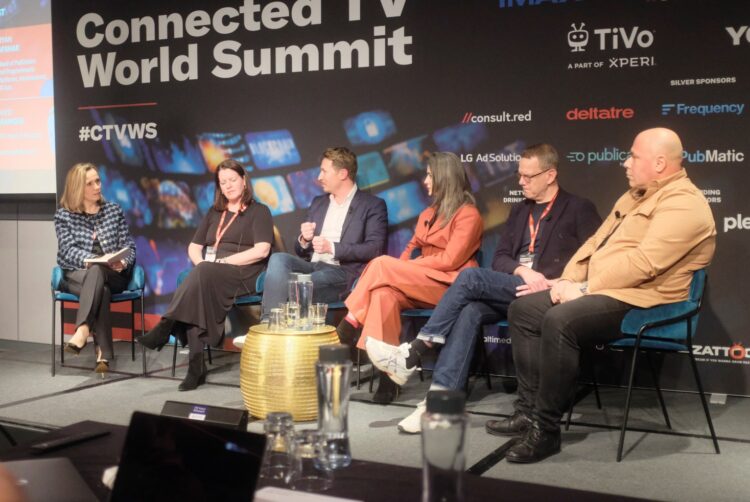How to replace lost linear audiences for advertisers

Connected TV World Summit 2024
At Connected TV World Summit, leaders in TV advertising debated how to best reach audiences in new environments — be it through connected TV (CTV), free ad-supported streaming television (FAST) or within smart TV operating systems — to head off losses in linear segments.
Ruth Cartwright, investment director at Sky Media, began the panel by disputing its premise. “We’re not losing [audiences] out the door to other media,” she said. “There is a linear decline, but actually what we’re seeing is those audiences viewing in different places. TV itself is actually growing. We are just sharing that ecosystem with more providers and streamers.”
David Grainger, head of planning at WPP agency EssenceMediacomX, partially pushed back on that notion, arguing that the splintered TV landscape has made things more difficult for brands. “Our impacts aren’t the same,” he said, adding that advertisers are waiting for CFlight “to really help us set the standard across linear and streaming audiences”.
“We’re at a bit of a Humpty Dumpty moment, where it’s fallen apart and we need to sort of put it back together again,” Grainger joked.
Retail innovations the direction of travel
The key to TV’s future success, then, according to Timothy Edwards, chief operating officer at independent smart TV operating system Titan OS, is “how we give advertisers the tools to reach these audiences in this streaming future”.
Those tools include innovations in advertising against smart TV homepages, as well as shoppable TV, among others.
“The key element with homepage advertising is we talk a lot about media fragmentation, but the homepage is the one place where everyone needs to access before they go off into these different media environments,” explained Edwards.
Ryan Afshar, head of publishers and programmatic platforms, international, at LG Ads, added: “Connected TV is so much more than just watching telly. It’s the first portal you come to to be entertained, whether that’s to watch a movie, listen to music, do karaoke or even see your security system.
“Lots of innovation we see for us is our home screen. We have real estate there. Increasingly, that’s an opportunity to be really creative. It’s the first ad that someone will see on their TV.”
Edwards said that the integration of retail media data into TV is also a major developing opportunity, as it can help advertisers improve targeting campaigns to customers. When paired with a future in which shoppable experiences can be offered through streaming services, retail’s future in the TV space is bright. “This is definitely the direction of travel in the industry,” Edwards noted.
Cartwright tempered the optimism, noting that innovation for commercial purposes alone could lead the TV industry into a trap that harms the overall user experience.
“We have customers as much as we do viewers,” she said. “If [certain] innovation is not going to sit well with the viewing experience for our customers, it will be difficult.”
What purpose does FAST serve?
There was debate among the panellists regarding the degree to which FAST will come to shape the future of the TV ad market, particularly outside the US, where it is considerably more popular than in Europe, where public-service broadcasters remain prominent.
The opportunity, explained Grainger, is that viewers can have an easy, “lean-back” experience watching TV for their niche interest that is curated. Whereas a streaming service like Amazon Prime Video might have a 50% bounce rate (where users browse content but don’t pick something to watch), FAST channels put the onus of responsibility for delivering content back on the broadcaster.
Afshar elaborated: “People like free TV and people often don’t know what they want to watch. FAST serves a purpose — just flick it on and watch.”
Pippa Scaife, vice-president of global growth strategy at NBCUniversal, tried to draw a distinction between the quality of FAST channels and the premium offer by more traditional broadcasters.
“Broadcast now is a full digital environment,” she said. “There is a piece of that pie that is all about premium content by heritage broadcasters. There’s also a part of it that’s about 10,000 FAST channels. It’s now a very broad spectrum and, within that, there are different need states.”
For Scaife, the interesting development in TV is that the screen itself is no longer necessarily a proxy for premium content. Anecdotally, she uses her own TV to view everything from Sky to YouTube. So, for Scaife, brands should take care to create integrations that factor in viewing habits.
Scaife also believes that the more premium side of broadcast and streaming will become increasingly important to attracting audiences, given the increase in viewing options through FAST flooding the market. “If you have 10,000 FAST channels, you can’t expect them all to be successful in three to four years,” she added.
Edwards pushed back on the somewhat strict delineation between FAST and “heritage broadcasters”, suggesting that there are premium brands making FAST channels, such as Bloomberg News.
‘Fish in the other pond’
With TV venturing further and further into digital — and with all the data that comes with such a movement — both Scaife and Afshar advocated for TV to not just compete for spend among TV budgets, but to start going after the majority of spend in the ad market that is being funnelled towards the big digital players: Alphabet, Meta, Amazon, Alibaba and ByteDance.
Likening the tactic to “fishing in the other pond”, the panellists agreed that, with the innovations coming to TV, it can become a more competitive medium as the marketing funnel collapses, so long as broadcasters and CTV providers continue to execute on their strengths and measurement capability improves.
“Content is king,” said Afshar, implying that TV offers high quality in spades. “We talk about discoverability as being queen.”
The panel was chaired by Victoria Davies, managing partner at consultancy Davies, Stoychev & Partners.



